Putting together an impressive resume is almost as important as your interview skills when applying for a job. The proper resume can get you noticed in a sea of applicants, while the wrong one can have hiring managers’ eyes glaze over with boredom. To stand out from the crowd and increase your chances of landing an art gallery management job, you need to craft your resume carefully. An effective resume helps you sell yourself and makes hiring managers want to learn more about you. It should be brief, professional, and accurate. A good resume gives hiring managers just enough information about you that they want to meet you for an interview. The best way to create a great resume is by looking at other people’s resumes and getting ideas from them. There are many different types of CV formats out there – so choose the one that feels most natural for you, bearing in mind that the focus should always be on selling yourself effectively as quickly as possible.
Art Gallery Manager Resume Example
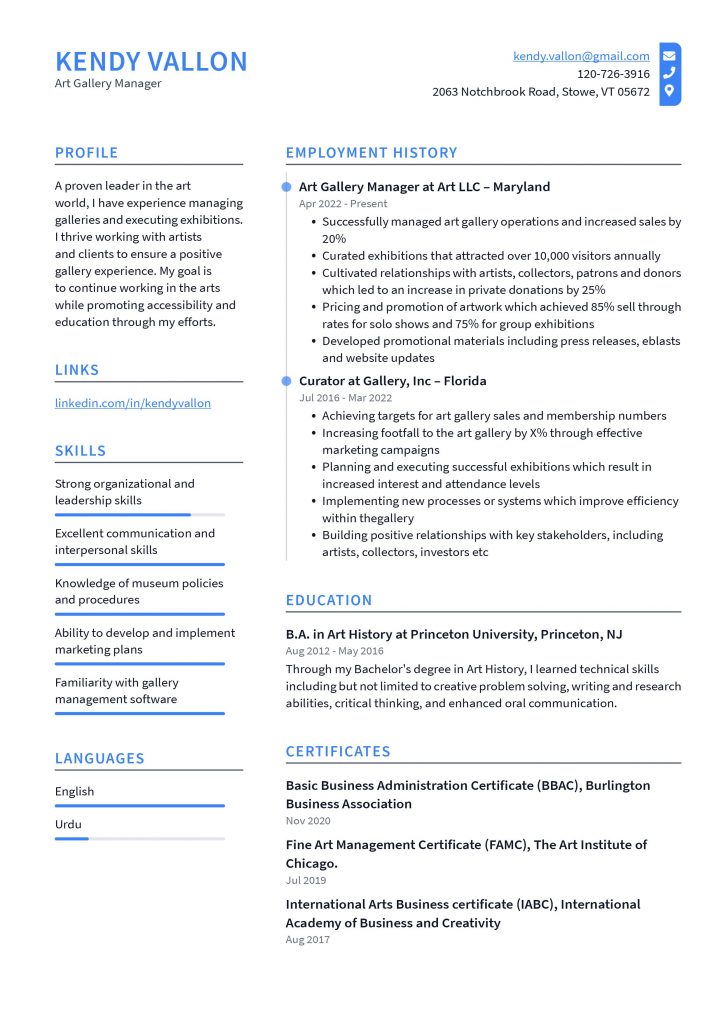
Download This Art Gallery Manager Resume as PDF
Art Gallery Director Resume Example
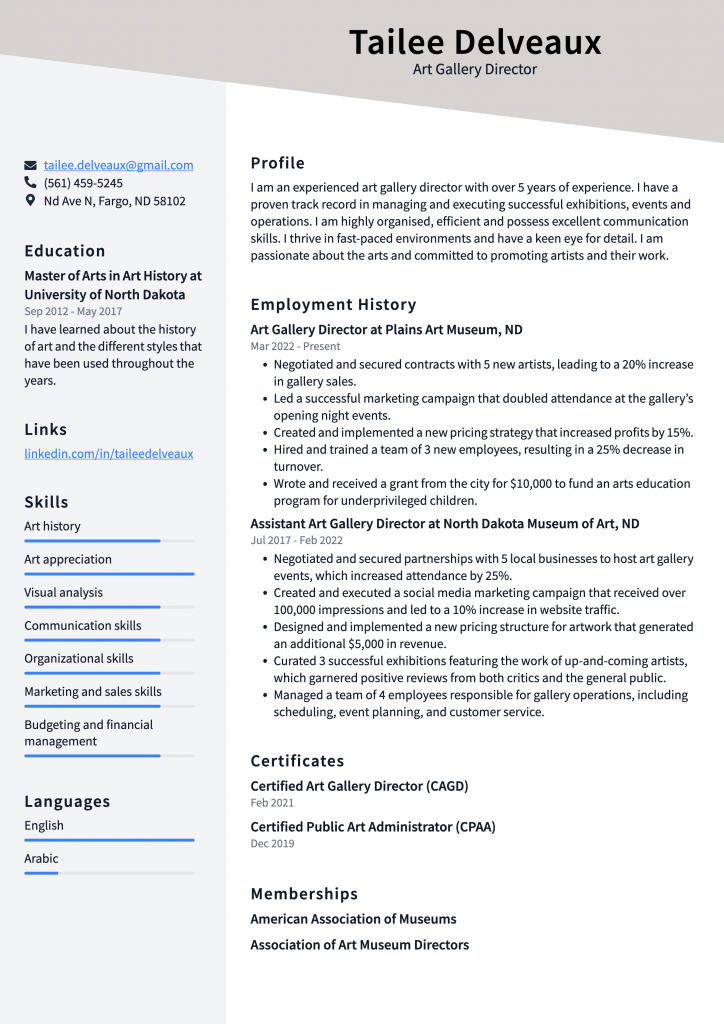
Download This Art Gallery Director Resume as PDF
Art Gallery Curator Resume Example
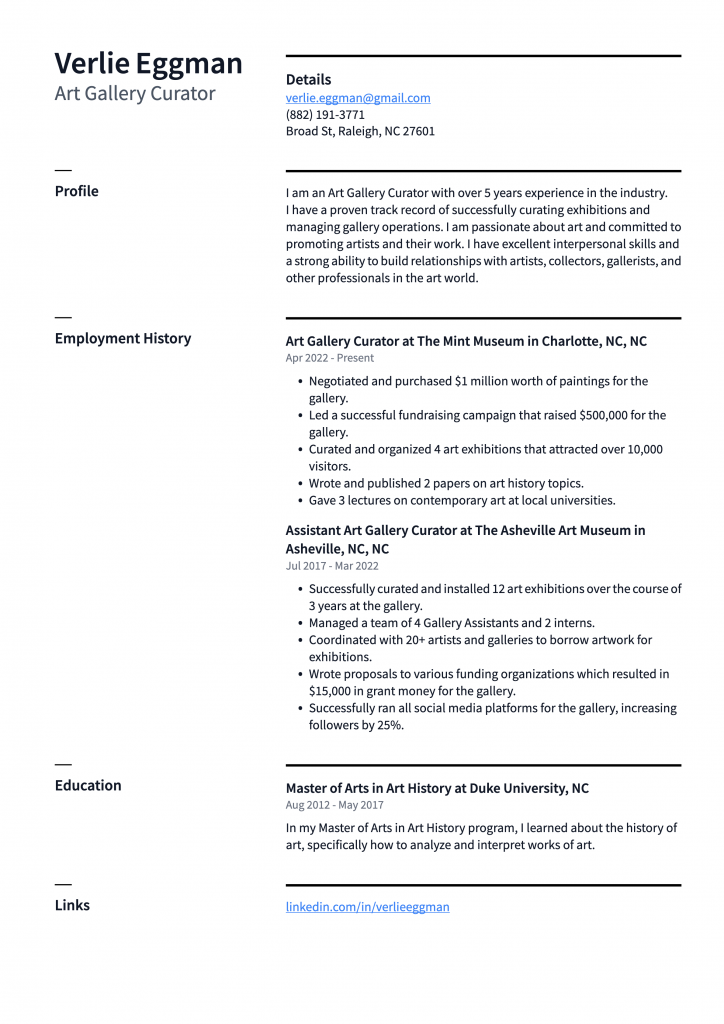
Download This Art Gallery Curator Resume as PDF
Art Consultant Resume Example
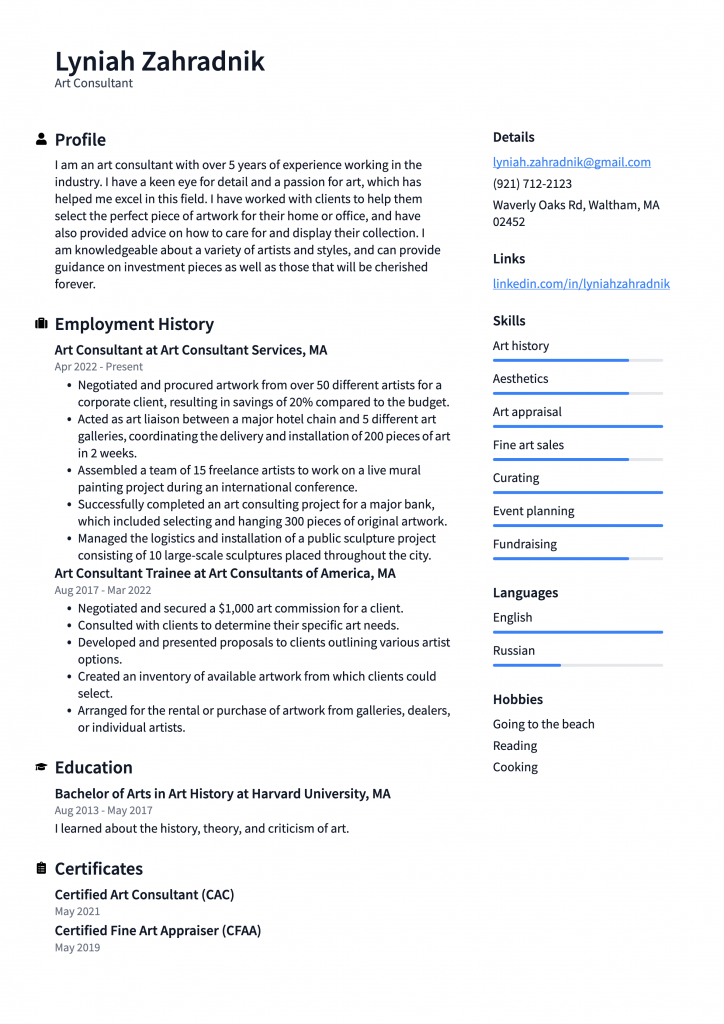
Download This Art Consultant Resume as PDF
Art Dealer Resume Example
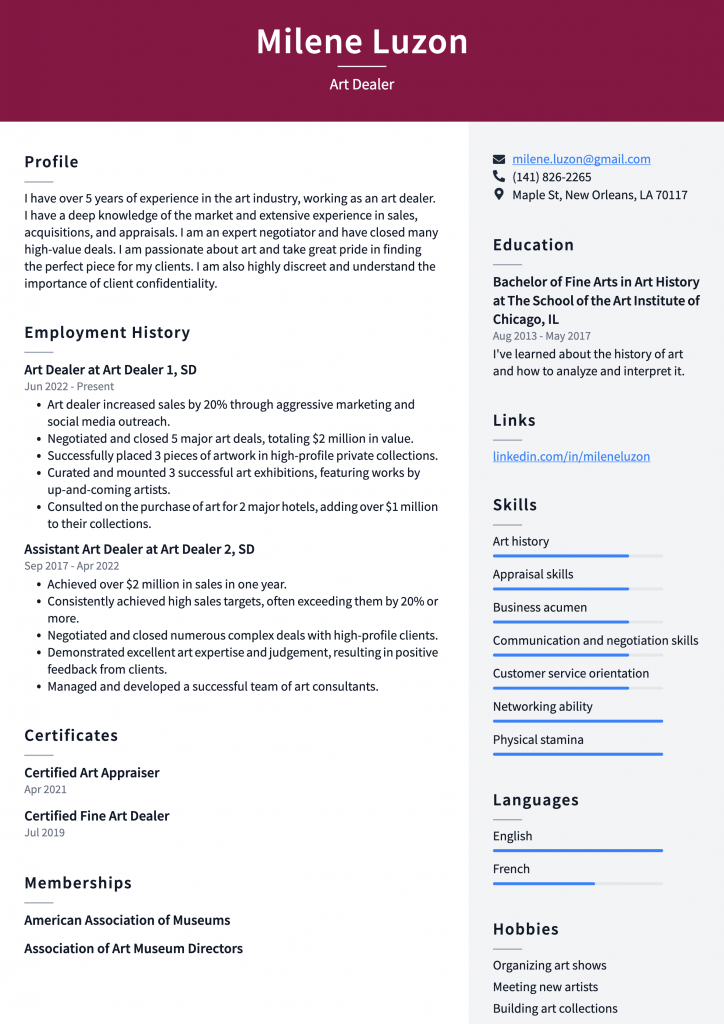
Download This Art Dealer Resume as PDF
Art Advisor Resume Example
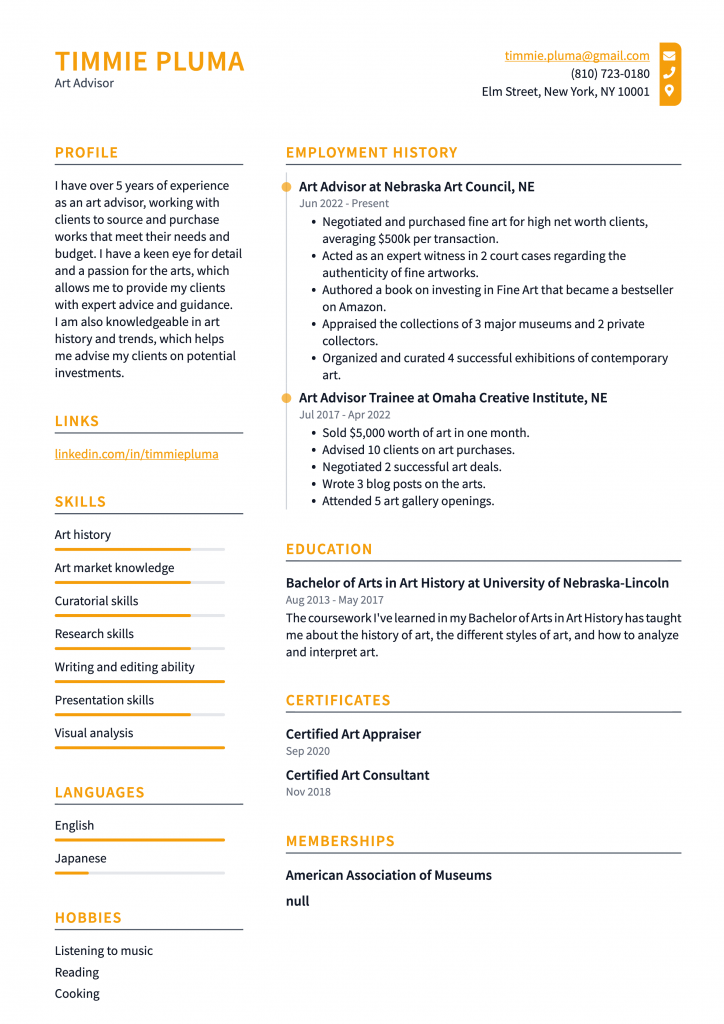
Download This Art Advisor Resume as PDF
Art Collector Resume Example
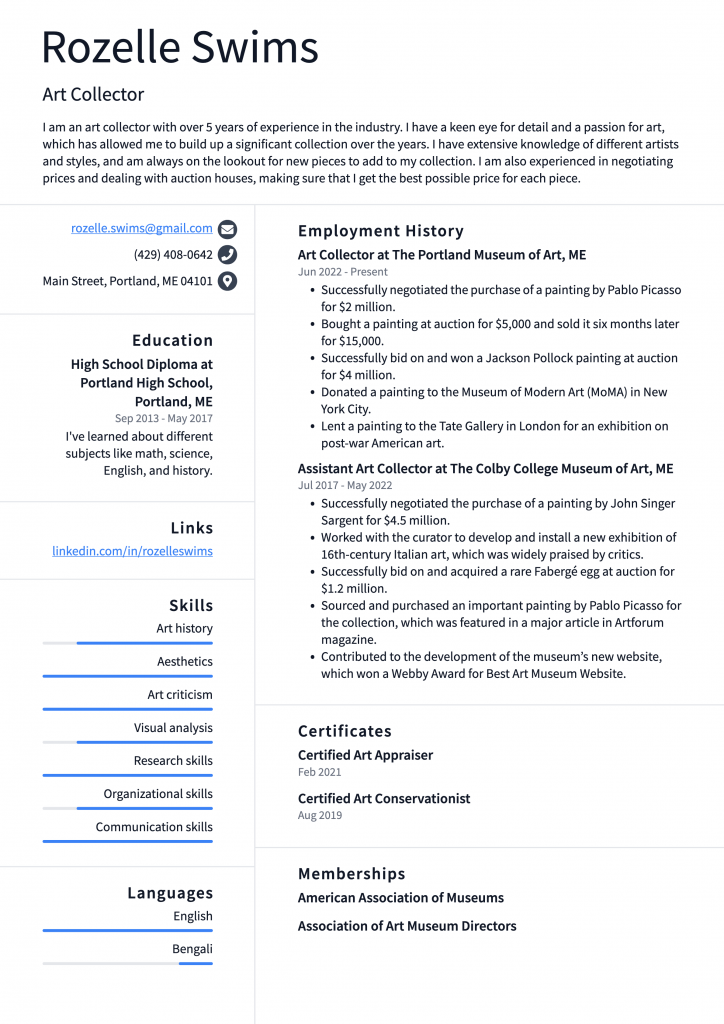
Download This Art Collector Resume as PDF
Create your own art gallery manager resume
When putting together your resume, remember that you will likely be applying for various jobs and industries. Make sure that your resume is as applicable to as many different positions as possible by keeping it concise and focused on your skills and experience rather than your job history. When constructing your resume, use keywords listed in the job posting and employers’ desired skills. Tailor your resume to each job by checking the company’s website or reviewing its job postings. Look for the critical skills and qualities that hiring managers are looking for in potential candidates. Since hiring managers usually take only a few seconds to skim your resume, make sure that your name, address, and phone number are placed in the upper left-hand corner. Also, include a summary of your skills at the top of your resume, followed by your work experience.
Use a professional resume template
A resume template is an introductory document that you can start with and then modify for each job you apply for. It’s an excellent tool for anyone who isn’t confident about their resume-writing skills because it allows you to focus on the content of your resume rather than on formatting and design. Not sure where to start? Check out online resume resources and see which resume format they recommend. You can also ask your former employers or colleagues if they have any recommendations for online resume builders and templates. In addition, many websites offer resume and CV templates for free and tutorials on how to use them effectively. These tools are usually effortless to click “upload” and “paste” the information into the template.
Make clear, concise headers
If you’re using a traditional resume format (i.e., not using a resume builder or a CV template), you need to decide how best to organize your experience and skills. A straightforward and easy-to-read layout is always best. Look at different resume examples to see how others have collected their information. When putting together your resume, think about what hiring managers want to know about you. They want to know what kind of experience you have, your education, and what you’re good at. Your resume highlights these critical points without being too wordy or repetitive.
List only recent and relevant experiences
When writing your resume, it’s tempting to include every single job you’ve ever held, no matter how long ago you owned it or how relevant it is to the job you’re applying for. Resist this urge, and only include jobs relevant to the position you’re applying for now and recent things (within the last five years, at most). For example, if you worked at a coffee shop as a barista five years ago, and that’s the only job you have on your resume, it might not be worth mentioning. On the other hand, if you worked as a barista at Starbucks for two years, that experience might be worth including, depending on the job you’re applying for.
Maintain consistent font size and format
Your resume is your first opportunity to make a good impression on a potential employer, so it’s vital to get the little details right. These details include your font choice, the alignment of your resume, and the spacing between your sections and headings. When choosing a font, stay away from fancy or overly decorative fonts. They make your resume look unprofessional and can turn hiring managers off. Instead, choose a simple and clean font, like Times New Roman or Calibri. Most hiring managers prefer that your resume is in standard, chronological format. However, some employers prefer a combination format, which includes a chronological section followed by a section with your skills and qualifications. If you’re applying for a creative position, you may be able to get away with putting your skills team first.
Sum up your skills at the end
If you’re applying for a job in a creative industry like art gallery management, you may consider including a “skills” section at the end of your resume. This is a great place to showcase any special skills or qualifications you have that would be difficult to fit into a standard resume format, like proficiency in a foreign language. You can also put your employment history (i.e., the jobs you’ve held and the dates) at the end of your resume or use a hybrid format to combine the two sections. Whatever you choose to do, make sure that your skills section is relevant to the job you’re applying for. If you’re not sure what to include, look at other resumes to see what skills hiring managers are looking for.
Wrapping up
A great resume can get you invited to interviews and help you get hired, so you want to put as much effort into it as possible. Remember to keep it concise, use a standard format, and include only the most relevant information to the job you’re applying for. When it comes to formatting, make sure that everything is neat and consistent, from your font choice to the spacing between sections. And remember: hiring managers are skimming through dozens of resumes, so make sure yours stands out from the crowd!